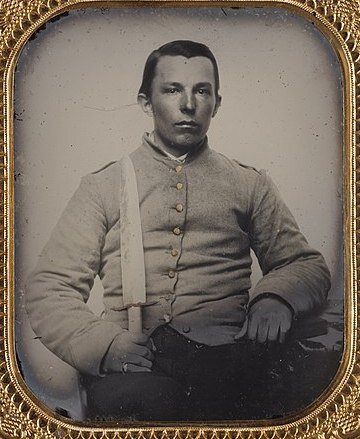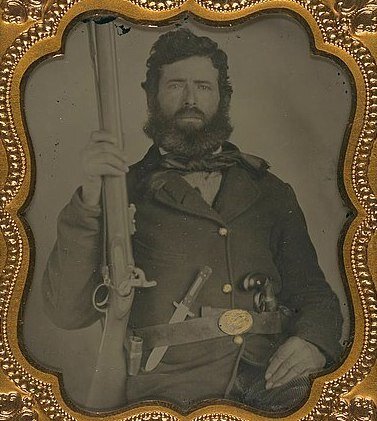The Uncertain, Clouded, and Mysterious History of the Bowie Knife
The history of the Bowie knife is disputable at best and arguable at worst.
Life on the American frontier was rough. There are countless stories of hardships, tragedy, and suffering from all people of the time period. Sometimes these afflictions were caused by random chance, sometimes by nature itself, and sometimes by fellow man. It was a place that lacked law and all of the stability it brings. It was a place where people often didn’t have an option to call for help. They needed to take care of their own basic needs; food, shelter, and protection. As a result, many sources from the time point to the fact that people often carried weapons on a daily basis. It was a necessity. Although most people remember the firearms frontiersman carried, it was also important to remember that knives were perhaps even more universal. One of the most well-known knives of the frontier was the Bowie knife.
If you are reading History of the West with Sam Payne; And the Wagons Rolled, you might have read that Sam purchased himself a Bowie knife in Nebraska City. While the history of the Bowie knife (pronounced Boo-e) is a little unclear, there are many historical sources indicating its use on the frontier.
In 1847, Francis Parkman wrote:
“American backwoodsmen in brown homespun, the well-beloved pistol and bowie-knife displayed openly at their sides.”
John Bratt would remember that in 1866:
“Nearly every man carried one or two revolvers on the well-filled belt of cartridges around his waist, besides a bowie knife sometimes stuck in his belt and sometimes stuck in the top of his high - legged boot.”
Both of these accounts document life on the northern plains. The Bowie knife was also popular further south. Texas Ranger James B. Gillett would also write that:
“For arms, the Ranger after 1877 carried a Winchester rifle or carbine, a Colt’s .45 revolver, and a bowie knife.”
Wherever you look, starting around the mid 1800’s, references to Bowie knives litter the historical record.
Although one could hardly argue they were not popular, there could be some argument over what those people are actually describing. Here is where the history of the Bowie knife gets a little complicated.
History of the Bowie Knife
Most sources indicate that the knife gained fame after The Sandbar fight in 1827. This fight actually started off as a duel between two men, but soon became a brawl involving many men. During the fight, James Bowie drew out “a big butcher knife” and killed at least one man with it. After the press caught wind of the fight, Bowie earned himself a reputation as a fierce knife fighter. Before long nearly everyone wanted a deadly blade just like his. The question was, what did the first Bowie knife actually look like?
The Texas State Historical Association’s website claims that “Early examples, however, had a thick, heavy butcher-knife-like blade, with a straight back (top) and no clip point or hand guard. The blade varied in length from 8½ to 12½ inches and was sharpened on the true edge. Wooden handles were attached with silver pins and washers.” This seems to be supported by other sources as well. Whatever the first Bowie knife looked it, it’s hard to debate the knife soon took on a variety of styles and sizes.
In the 1830’s the popularity of the Bowie knife really took off. During that time, a cutler named Daniel Searles had earned a reputation for making Bowie knives.
Over time the Bowie knife continued to change shape. It seems the most popular style incorporated a clipped point, handguard, and coffin-shaped handle. This design has almost become the default version of the Bowie knife today. It’s probably easy to realize that as different makers created these popular blades, they probably did take on a life of their own. By the Civil War, many of the large knives soldiers carried were tagged as Bowie knives. Here are a few examples of Civil War soldiers carrying different knives all noted at Bowie.
As you can see, the term Bowie knife didn’t necessarily mean one specific shape and size. Rather, it seems to have indicated a more general reference to a large knife. It would be hard to say why this happened. Perhaps it was a prestige issue. People wanted a Bowie knife, they just wanted it to be what they had. Or maybe it was a communication error. Maybe people thought they knew what the knives looked like, but actually had either heard or remembered incorrectly. By the time of John Bratt in 1866, the term could simply have indicated a large fixed blade knife of any style. For example, people in some regions ask for a “coke” and then order a Dr. Pepper. Coca-Cola started as a specific type of beverage but soon became so universal it came to represent the entire type of beverage. That might be the case with the Bowie knife.
Modern Bowie Knives
Today, there are a variety of dealers that offer Bowie style knives.
The link above takes you to one good replica on Amazon. The knife listed is made from Sandvik 12C27 Steel. Whenever you buy a knife, it’s important to be aware of the steel used. More than anything, when you buy a knife, you should be buying the steel. Sandvik 12C27 steel is widely used and reported to be good for hunting-type blades. If you want to get one reviewer’s take on different types of steel, open this link.
The history of the Bowie knife might be a little unclear, but the reality is that knives were very common on the American frontier. A large fixed blade knife that could stand up to many chores was simply essential. Whether that blade had a clipped point, handguard, or had pins in the handle probably didn’t matter as much as its utility. Life on the frontier was rough, and people needed a durable knife to stand up to the test.





